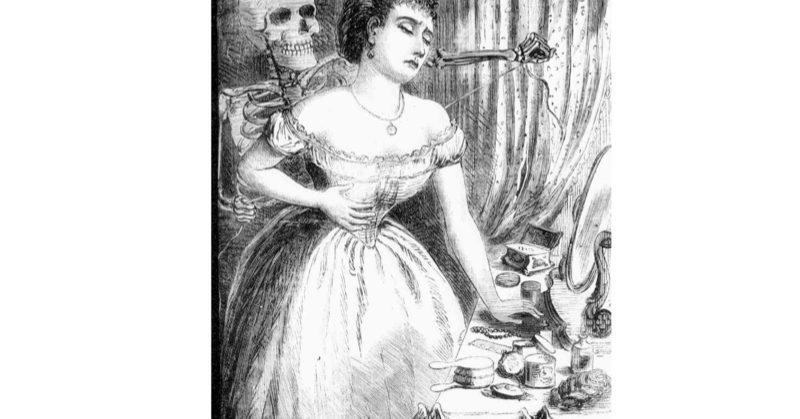10 weird and wonderful historical newspaper stories – BBC History Magazine
Singing animals, cringe-worthy falls, dancing babies… today's media is full of bizarre stories and videos. But our love of the weird and wonderful is anything but a modern phenomenon, as Rona Levin proves…
In Comic, Curious & Quirky: News Stories From Centuries Past, Levin pulls together some of the most bizarre tales to fill the columns of newspapers as far back as the 1700s – from the woman who in 1830 poisoned her dinner guests, then died, having forgotten she'd used the same saucepan just days before to boil arsenic for the purpose of eradicating vermin, to a marriage between a corpse and his living spiritualist bride in 1856.
Levin trawled the vast British Library newspaper archive in order to find the tales featured in her book. Here, writing for History Extra, she rounds up 10 of the strangest stories she came across:
I leave it up to the reader's imagination as to why this idea, reported in the Leeds Intelligencer on 23 July 1853, did not catch on despite, on the face of it, offering an eco-friendly and cheap solution for papering over the cracks of a housing shortage: “Messrs. Bielefeld have commenced the manufacture of papier-mâché houses.
“The framework, the flooring, and the doors are of wood, but the rest is constructed of paper. A number of cottages, stores and villas have been erected at Messrs Bielefeld's works at Staines; and a gentleman has purchased them as an investment for Australia, whither he is going. These buildings can readily be taken down, and re-erected in a few hours.
“They have hollow walls, so that damp is excluded; and tropical insects will not attack the paper, for the poisonous ingredients it contains.”
Who came up with the idea of adding service charges to bills? Possibly this man, who wrote to The London Magazine in 1768 with such a proposition, having suffered abusive staff pestering for tips: “I speak of the licensed beggars you meet at every inn, when no sooner is the bill called for, but the setters prick up their ears, and scamper to obstruct the avenues of retreat.
“The appearance on the way to your horse and carriage of everyone concerned to deliver what you have ordered, give intimations of their demands upon you, as you hear them bawl out: ‘Pray remember the ostler', ‘the waiter', 'the boot-catcher’.
“Let landlords pay their servants sufficient wages, and at the bottom of the bill, write attendance, leaving a blank for the person to give what he pleases; you will find it much easier to make the landlord an allowance for that purpose, than to cram the hungry jaws of his gaping cormorants, who are so irregularly fed.”
The following was a fatal recipe for a dinner date reported in the Northampton Mercury, 11 September 1830: “Mrs Shaw, wife of Thomas Shaw, mercer and draper, boiled a leg of mutton for her family in a saucepan which had some days previously been used to boil arsenic for the purpose of destroying vermin.
“When the dinner was prepared, Mrs Shaw sent part of the broth to a young man who was unwell, and partook of some herself. The Rev John Hughes, Wesleyan Minister, having called in, was invited to dinner. He and Mr Shaw sat down, and were in the act of eating, when Mrs Shaw was taken suddenly ill; and, as the use previously made of the saucepan in which she prepared the broth returned to her mind, she desired them to eat no more.
“The unfortunate woman lingered in great pain until Saturday evening, when she expired.”
A revolting description of a royal cadaver appeared in the Hereford Journal on 4 January 1781: “The body of the late Empress [Maria Theresa, last of the House of Hapsburg and mother of Queen Marie Antoinette of France] was opened on the 30th of last month in Vienna… and it afforded matter of astonishment that she did not die of a dropsy [swelling of soft tissues due to the accumulation of excess water], as was believed, no water being found in the breast, but a great quantity of fat and viscous matter, which is attributed to Her Majesty having accustomed herself, from her youth, never to spit.
“The resignation of that great Princess has been much admired; for, the nature of her disorder not permitting her to lie on a bed, she was obliged to rest on a sofa, almost always in the same position, which was extremely uneasy.”
In Dublin, the Paisley Herald and Renfrewshire Advertiser of 13 January 1872 reported: “It is a painful thing to see a corpse carried to the grave in an ugly black box under a mourning coach. It shows a want of respect for the dead person, for the relatives sit comfortably cushioned in a snug carriage while the poor dead person is shoved into a vulgar box, within a few inches of the surface of the road, and under their feet.
“In dirty weather this horrid box is bespattered with mud. The Dublin Police Commissioners have abolished this disgraceful custom: they have issued regulations that no coffin or corpse shall be conveyed in any carriage or hearse constructed also for the conveyance of passengers.”
It is extremely rare for a senior member of the royal family to be summoned to court, but, the Staffordshire Advertiser reports, her majesty the Queen Dowager [Adelaide, the widow of William IV] was summoned by the rate collectors of the parish of St Martin to attend at the Westminster petty session on 10 August 1838 to answer for the non-payment of £104 and some shillings:
“This sum was due to the parish of St Martin as a quarter’s poor rate for Her Majesty’s residence, Marlborough House. Her Majesty, it appears, was willing to pay the rate demanded as a donation, but she objected to pay it as a rate.
“This, the parish refused to accede to, and proceedings were instituted. On the opening of the court, Mr Sergeant Merewether, Her Majesty’s Solicitor-General, was in attendance; but the case was, by consent, adjourned.”
It was ultimately agreed to accept the money as a donation.
The road to Wigan fear was described in the Bradford Daily Telegraph on 9 January 1875: “Wigan has narrowly escaped a terrible disaster. A drunken carter was observed driving throughout the town a horse drawing a cart laden with about a tonne of gunpowder, the barrels containing which were only partially covered by a tarpaulin.
“The police took possession of the vehicle, and locked up the driver, who was described as having been very drunk. The danger of an explosion was enhanced by the fact that the road was very slippery, and that the carter, who was seated on the cart, had in his possession a number of Lucifer matches. The magistrate fined the man 20s. for being drunk, and on Thursday his employer appeared at the police court to answer a charge of conveying the powder in question through the streets without its being properly covered.”
A real-life English Pooh-Bah character is described in the Sheffield Evening Telegraph on 23 December 1887: “Truth describes the duties of an English official at Labuan, a possession of this country in North Borneo, who seems to have as many functions as Pooh-Bah in the opera The Mikado.
“There are only two English officials, Governor Leys and Lieutenant Hamilton. The latter gentleman combines in himself the offices of colonial secretary, postmaster, treasurer, magistrate, inspector of police, inspector of the prison, chief commissioner of woods, colonial engineer, and master attendant. In these various capacities he corresponds from himself to himself in the most stately official style, and carefully copies and registers his numerous despatches.”
This report in the Worcester Chronicle on 30 November 1859 offers food for thought: “There is at present in the Bradford Infirmary a basket-maker, named Charles Sutton, who has been suffering from symptoms referable to poisoning by lead. He has lost the use of his hands, but is improving under treatment.
“After much fruitless inquiry as to the cause, it was found that the man had been wont to eat pork which had been pickled in a leaden cistern. It is said to be the practice of pork butchers at Bradford, and perhaps elsewhere, to pickle pork in such cisterns, under the idea that the process is thereby facilitated. The plan, however, is fraught with danger to life, as the lead is certain to be corroded by the salt.”
“Within the last few years a cruel disease hath robbed the fairer sex of their charms”, reported the Leeds Intelligencer on 5 July 1768. “This distemper is epidemical: it was imported from France, first among the Court ladies; it then seized the citizens’ wives and daughters; and now it begins to make dreadful ravages in the country.
“It affects the head which swells all at once to an enormous size, with a tumour so prodigious as to make the patient totter under the weight of it, and when the disease has been of long continuance, it generally produces a violent itching. The French call it Tête de Mouton because it makes the patient look like a ram.
“Some time after the head is swollen to a monstrous magnitude, it sends forth a foetid smell, and generally breeds vermin, the maggots, which were first in the inside of the head, afterwards appearing outwardly.”
Rona Levin is the author of Comic, Curious & Quirky: News Stories From Centuries Past (British Library, 2014). To find out more, click here.
Start the year with a subscription to BBC History Magazine – £5 for your first 5 issues!
As a print subscriber you also get FREE membership to HistoryExtra.com worth £34.99 + 50% London Art Fair 2024 Tickets
Sign up to receive our newsletter!
By entering your details, you are agreeing to our terms and conditions and privacy policy. You can unsubscribe at any time.
PLUS HistoryExtra membership worth £34.99!
Save 70% on the shop price when you subscribe today – Get 13 issues for just $49.99 + FREE access to HistoryExtra.com
Listen to the latest episodes now




